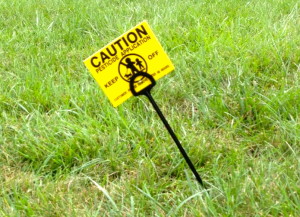 I grew up in Baltimore County where perfectly manicured lawns were non-negotiable. In the background of passing mini-vans chauffeuring kids around and neighborhood games of tag were the tiny yellow caution signs in lawns recently treated with pesticides.
I grew up in Baltimore County where perfectly manicured lawns were non-negotiable. In the background of passing mini-vans chauffeuring kids around and neighborhood games of tag were the tiny yellow caution signs in lawns recently treated with pesticides.
Beyond purposefully dodging the lawn for the first 48 hours after treatment, I never gave these signs any thought. It was just something you did without question. I never connected the dots and thought about what the signs really meant. It was not until last year, sitting in a meeting with the Smart on Pesticides Campaign that I realized I had been exposed to pesticides my entire life.
I went home to visit last weekend and was greeted, once again, by one of these small yellow signs in my parent’s front yard. This time I paid a little more attention to it.
The Smart on Pesticides Campaign has made me highly aware of the threats pesticides pose to public health and the lack of information we have on their application. Pesticides have been linked to chronic diseases, such as cancer and Parkinson’s disease. With health impacts as serious as those, is a tiny yellow sign really enough? The more I think about this sign the more I wonder if its size was chosen to purposefully downplay the seriousness of pesticide exposure. The message on the sign is serious. I mean there is a reason to keep off of the lawn for the first 48 hours after treatment. But somehow the size makes the message insignificant (at least to me). To me it conveys that yes you need to stay off of the lawn for a little bit, but it is really not a big deal. I wonder how large these signs would be if they were required to be proportional to the implications of pesticide exposure?
If these caution signs are required for small private homes, can you imagine what type of caution is needed for pesticides applied in such high concentrations on cropland? What is concerning is that we do not know when these fields are treated and what they are treated with. It would be one thing if the areas they were applied to were encased in a bubble and those exposed to pesticides were only done so by choice, but that is simply not how it works. There is a lot we do not know about their use and it is important that we find out.
The Smart on Pesticides Campaign has gone to summer school to ensure that a summer study workgroup for a state pesticide reporting database results in positive recommendations. Sign up for Maryland Pesticide Network E-News List to stay connected to the issue.